In the second instalment with Pietro Marcello on Scarlet (L'envol), his adaptation with Maurizio Braucci (Marcello’s Martin Eden, Abel Ferrara’s Pasolini) and Maud Ameline (Mikhaël Hers’ Amanda), in collaboration with Geneviève Brisac of the 1923 novel Scarlet Sails by Russian author Alexander Grin (starring Raphaël Thiéry, Juliette Jouan, Louis Garrel, Noémie Lvovsky, and Yolande Moreau), we discuss the influence of Vittorio De Sica’s Miracle In Milan (Miracolo a Milano, 1951), the chance discovery of Louise Michel’s poetry, fathers as mothers, dethroning princes and knights in shining armour, being an archivist, Louis Garrel’s crocodile entrance, Pietro’s new project on the question what is war, and the end credit thanks in Scarlet to Renato Berta, Caroline Champetier and Gianfranco Rosi.
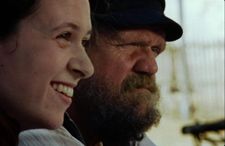 |
| Raphaël (Raphaël Thiéry) with his daughter Juliette (Juliette Jouan) in Scarlet |
Scarlet tells the story of Raphaël (Raphaël Thiéry) returning from the front to the village where he lived. He is a big man with strong hands, a woodworker with great artistic talent and a love of music. His wife Marie had died in the meantime and he finds out that his baby daughter Juliette (Victoire Battist, as a young adult played by Juliette Jouan) is being taken care of by Madame Adeline (Noémie Lvovsky) who lives in a farmhouse outside the village. She offers Raphaël room and board and a platonic friendship that will last for years to come. Together with the family of a blacksmith (Antonin Stahly Viswanadhan, Inès Es Sarhir, Athénaïs Sifaoui-Blanc) she also takes in, they form an unusual and modern union of outsiders.
An airship, as predicted by the local sorceress, falls from the sky, containing the handsomely moustached Jean (Louis Garrel) who woos Juliette with his charm and utterly modern outlook on interwar 20th century life. And yet, as is often overlooked, it is as in many fairy tales that the damsel is rescuing the prince. Don’t forget, Rapunzel, single mother of twins, thrown out from her home is the one who restores eyesight to the prince with her magical tears.
In Scarlet the couple meets swimming in a lake and, as is the case in Beauty And The Beast, the story evolves around love for the father and love for a lover, a difference that needs to be sorted out. Garrel’s Jean seems a little perplexed that his charms don’t work more magic, but also relieved at the same time.
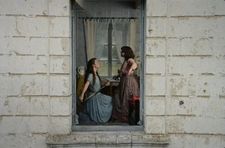 |
| Juliette (Juliette Jouan) with her friend Inès (Inès Es Sarhir) |
Winds are blowing and freedom is what we all desire. The ghosts of the past stand behind the window and the arsonists of the future are ready to strike - this is the space where Scarlet is located.
From Rome, Pietro Marcello joined me on Zoom for a second in-depth conversation on Scarlet.
Anne-Katrin Titze: Hi Pietro!
Pietro Marcello: How are you? Here in Rome it’s becoming hot!
AKT: Summertime?
PM: Summertime. It’s hot already!
AKT: We spoke about Scarlet at the New York Film Festival, so this will be the second part.
PM: Yes, wonderful.
AKT: Let’s begin with Alexander Grin and Louise Michel, both not really household names that people are familiar with. How did the novel cross your path and how the poetry by Louise Michel?
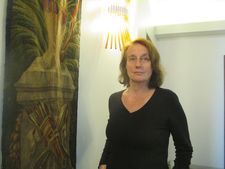 |
| Pietro Marcello on Caroline Champetier: “She lent me her Pentax camera, which are very hard to find.” Photo: Anne-Katrin Titze |
PM: We found it on the farm! I really only came across this book of poetry by chance while we were doing the shooting. It was then that we decided to have Juliette read those poems.
AKT: It fits beautifully. And Alexander Grin?
PM: Alexander Grin because my producer Charles Gillibert he gave me this book to read after Martin Eden, because I was in France because of family issues and then that proposal came to me for production and Alexander Grin ended up in my hands.
AKT: I was not familiar with either of the authors and I’m happy to know more about them now. It is unimaginable to have this film without the actor who plays Raphaël. His hands! His face! Can you tell me about finding him for the story?
PM: My wish was to find the best actor for the film. I needed to find a carpenter for the character. I have great respect for artisans and wanted to find someone who could create things with their hands. This is my first French film, so I had to rely on help from others. Because after Martin Eden I didn’t really have an urgent need to make a film. It’s also a very personal film. It was shot during the Covid pandemic and using kind of wartime economy.
AKT: There is a mysterious moment in the film. If you don’t want to say anything about it, that’s fine. I’m talking about the woman, the widow on the train. We don’t know how she’s related, she shows up and disappears.
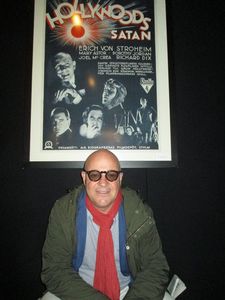 |
| Pietro Marcello on Gianfranco Rosi: “We’ve known each other for years.” Photo: Anne-Katrin Titze |
PM: The idea was to put together two widows; she is a widow dressed in black and he is a widower. I thought it would be good to put them on a train together in this mysterious moment in the film. It’s that simple.
AKT: Strangers on a train! What you do so well is mix styles and genre. You start with the archival armistice footage and there is even a moment when Juliette asks the magpie, the bird, if it has magical powers. Cinema does, and at that point it turns to animation, right?
PM: Maybe it’s my desire to find other inroads. My training was as a documentary filmmaker and deep down I’m an archivist. I experiment until I have the possibility to make a film and then I put together these different forms and make them coexist in a way that is also cohesive. Right now I’m making a documentary film, using archival footage of war. The link in fiction is to make it all coexist.
AKT: What is this current project about?
PM: It’s part of an anthology. It’s kind of a didactic film in my point of view. It’s asking the question what is war and then showing it from Cain and Abel until today.
AKT: At the beginning of Scarlet there is a scene when Raphaël returning walks through a village and on the street are children playing war. One girl is dressed as a nurse. The connection made between childhood and war is so profound here. We see with a number of characters how childhood experiences turn them into who they later become.
PM: The scene is a reconstruction using archival photographs. As I went looking for iconographic images in archives I found many many pictures of children playing war-games. Pictures taken both during and after the war. Their parents had experienced horrors of war and we see children emulating adults and war play.
 |
| Pietro Marcello on Louis Garrel, as Jean, swimming like a crocodile in Scarlet: “It’s true! That’s also the way it looked while we were filming.” Photo: Anne-Katrin Titze |
AKT: The wooden toys have an archival quality as well. Very personal to me, they reminded me of toys my grandfather made for me out of wood when I was little. On the other hand, the witchcraft-y things we previously talked about our grandmothers doing. Were there also archival photographic references for the toys and the magic you were looking for?
PM: Many of the ideas we came up with during the shooting. It’s harder and harder to make a historical film today that is not glossy about the past. So the camera we used and the style of shooting was very much in the style of a historical report. We shot it in a very simple way and a very non-academic film is the result. The ideas we came up with were born from need, out of necessity.
AKT: I noticed in the end credits a few names that you thank. Cinematographers, for instance, Renato Berta, Caroline Champetier, Gianfranco Rosi.
PM: Renato Berta, in addition to being a friend, he is also a teacher. I consider myself a photographer, but he is a great photographer. Thanks to Caroline Champetier we were able to shoot in 35mm. She lent me her Pentax camera, which are very hard to find. And finally Gianfranco Rosi, he’s an old friend. We’ve known each other for years.
AKT: The quote at the beginning speaks of doing magic with your hands. Is there anything this character Raphaël cannot do? You even have him make soup, so besides the woodwork and the music, he’s a chef, a cook too! Is his gigantic talent taken from the novel? Or did you give him extra powers?
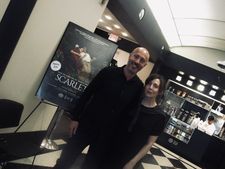 |
| Cinecittà Studios Chief Nicola Maccanico with Anne-Katrin Titze in front of the US Scarlet poster at Open Roads: New Italian Cinema in New York Photo: Sally Fischer |
PM: A lot of things were changed in the story. For me there is no real male/female divide in the figure of Raphaël. He is both mother and father. You could say he’s the man of four seasons. What matters about him is that he’s solid. He’s a solid father but also a solid mother. What is implied by this is a different vision of the mother/father family, which is the idea of an enlarged family. In a sense the parental roles have changed. Once upon a time children would be left with other families and the father was also often absent for various reasons. I guess in this sense there has been progress. I hope I’m not wrong.
AKT: Well, recently I spoke with Cédric Klapisch about his film Rise and there is the line “Fathers rarely make for good mothers.” You totally prove him wrong! Here is a “good-mother father.” The extended family in your film contains Marek and Fatima. They are part of this group of outsiders, the immigrants, people who are shunned by the villagers and live in this court of miracles that doesn’t have a word in English for it.
PM: I like the idea of what we call in Italian and also in French a kind of court of miracles, which is this gathering of the rejects of society, the people that the village has rejected. This is something that always happens; there are many many evil villagers in the world. There is really nothing strange about finding the people rejected living on the outskirts of the village. I really like the idea of all these people living together in a way that’s reminiscent of Miracle In Milan by De Sica, where we find all these sort of losers living in this ghetto and learning to live together. And also learning to help each other by living together.
AKT: When Louis Garrel first approaches Juliette from the water, he looks like a crocodile.
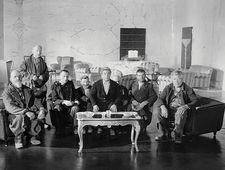 |
| Pietro Marcello on Vittorio De Sica’s Miracle In Milan influencing Scarlet: “There is really nothing strange about finding the people rejected living on the outskirts of the village.” |
PM: It’s true! That’s also the way it looked while we were filming. In Scarlet there is also the undermining of the idea of the Knight in Shining Armor. That has changed very much and Juliette is given a much more important role than in a traditional fairy-tale version of the story. We tilted the story more in favor of Juliette.
This figure of the Prince has changed. No one believes in this anymore, not even my little daughter. Who is going to wait around for the Prince to come and rescue them? Juliette is someone who follows her own road; she doesn’t need a Prince to come along and rescue her. Nor does she need to replace her father or rebuild her father through another man. I think the most important moment in the film is after Raphaël dies, we see Juliette working in the shop of a luthier, making a violin. This is true emancipation. There she is continuing the work of her father carrying on his legacy.
AKT: In multiple ways, through music and woodwork! Thank you, always so nice to see you again.
PM: Yes! See you next time in New York!
Read what Pietro Marcello had to say on composer Gabriel Yared, costume designer Pascaline Chavanne, and his use of archival footage in Scarlet.
Scarlet opens in US cinemas on Friday, June 9.






















